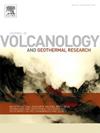Sintering dynamics of fine-grained rhyolitic obsidian particles from Hrafntinnuhryggur (Krafla, Iceland) with implications for silicic volcanic eruptions
IF 2.3
3区 地球科学
Q2 GEOSCIENCES, MULTIDISCIPLINARY
Journal of Volcanology and Geothermal Research
Pub Date : 2025-04-10
DOI:10.1016/j.jvolgeores.2025.108330
引用次数: 0
Abstract
Sintering – or welding – is a key process in volcanic eruptions and controls the formation of welded ignimbrites, obsidian pyroclasts in volcanic conduits, and possibly also silicic lavas. Here, we study the sintering behaviour of packs of fine-grained particles of rhyolitic obsidian subjected to different temperature pathways at atmospheric pressure, with a focus on the evolution of the total porosity of the sintering pack and material microtexture. We collect high-resolution continuous in situ data for obsidian sintering and compare our results with the ‘vented bubble model’ – a versatile model for viscous sintering kinetics. This model accounts for syn-sintering degassing and outgassing of dissolved H2O, which affects the particle viscosity. We also account for polydisperse particle size distributions, and arbitrary thermal history – i.e. any heating or cooling pathway and/or isothermal conditions. We find that the model performs well for fine particles sieved to . For particles , sintering changes rate compared with the model and finally occurs more slowly than the model prediction. We explore this deviation by defining a capillary Peclet number which balances the rates of diffusive loss of H2O from the particles with rates of sintering; particles that are relatively large compared with the diffusive lengthscale (here ) have large and therefore it is likely that deviations from the model are associated with substantial intra-clast gradients in H2O, which translate to viscosity gradients. However, the efficacy of the model for relatively small particles and across a range of conditions demonstrates its general applicability to natural scenarios in which relatively small obsidian particles () are deposited hot, and weld together to form variably dense deposits. After model validation, we apply this model to the case of sintering at Hrafntinnuhryggur (Krafla, Iceland) where a ridge of obsidian is interpreted to have formed through sintering of fine hot particles during a rhyolitic fissure eruption. In this application, we discuss the effects of intra-grain vesiculation and nanolite crystal precipitation, and what role those additional process would play in sintering. Using these results, we propose a sintering timescale map for obsidian sintering at rhyolite volcanoes, which will be useful for understanding silicic volcanic eruptions.
Hrafntinnuhryggur (Krafla, Iceland)细粒流纹岩黑曜岩颗粒的烧结动力学及其对硅质火山喷发的影响
烧结-或焊接-是火山喷发的关键过程,控制着火山导管中焊接的火成岩、黑曜岩火山碎屑的形成,也可能是硅熔岩的形成。在此,我们研究了流纹岩黑曜岩在不同温度路径下的烧结行为,重点研究了烧结包的总孔隙率和材料微观结构的演变。我们收集了黑曜石烧结的高分辨率连续原位数据,并将我们的结果与“排气气泡模型”(一种用于粘性烧结动力学的通用模型)进行了比较。该模型考虑了同步烧结过程中溶解水的脱气和出气对颗粒粘度的影响。我们还考虑了多分散粒度分布和任意热历史-即任何加热或冷却途径和/或等温条件。我们发现该模型对筛分≤63μm的细颗粒表现良好。对于颗粒>;63μm,烧结速率较模型变化,最终烧结速度较模型预测慢。我们通过定义毛细管佩莱特数Pc来探讨这种偏差,该Pc平衡了颗粒中H2O的扩散损失速率和烧结速率;与扩散长度尺度(此处为63μm)相比,相对较大的颗粒具有较大的Pc > 10,因此与模型的偏差可能与H2O中大量的碎屑内梯度有关,这些梯度转化为粘度梯度。然而,该模型在相对较小的颗粒和一系列条件下的有效性表明,它普遍适用于相对较小的黑曜石颗粒(≤63μm)热沉积,并焊接在一起形成不同密度的沉积物的自然场景。经过模型验证后,我们将该模型应用于Hrafntinnuhryggur(冰岛克拉夫拉)烧结的情况,其中黑曜岩脊被解释为在流纹岩裂隙喷发期间通过烧结细小热颗粒形成的。在这个应用中,我们讨论了晶粒内囊泡和纳米石晶体沉淀的影响,以及这些附加过程在烧结中所起的作用。利用这些结果,我们提出了流纹岩火山黑曜石烧结时标图,这将有助于了解硅质火山喷发。
本文章由计算机程序翻译,如有差异,请以英文原文为准。
求助全文
约1分钟内获得全文
求助全文
来源期刊
CiteScore
5.90
自引率
13.80%
发文量
183
审稿时长
19.7 weeks
期刊介绍:
An international research journal with focus on volcanic and geothermal processes and their impact on the environment and society.
Submission of papers covering the following aspects of volcanology and geothermal research are encouraged:
(1) Geological aspects of volcanic systems: volcano stratigraphy, structure and tectonic influence; eruptive history; evolution of volcanic landforms; eruption style and progress; dispersal patterns of lava and ash; analysis of real-time eruption observations.
(2) Geochemical and petrological aspects of volcanic rocks: magma genesis and evolution; crystallization; volatile compositions, solubility, and degassing; volcanic petrography and textural analysis.
(3) Hydrology, geochemistry and measurement of volcanic and hydrothermal fluids: volcanic gas emissions; fumaroles and springs; crater lakes; hydrothermal mineralization.
(4) Geophysical aspects of volcanic systems: physical properties of volcanic rocks and magmas; heat flow studies; volcano seismology, geodesy and remote sensing.
(5) Computational modeling and experimental simulation of magmatic and hydrothermal processes: eruption dynamics; magma transport and storage; plume dynamics and ash dispersal; lava flow dynamics; hydrothermal fluid flow; thermodynamics of aqueous fluids and melts.
(6) Volcano hazard and risk research: hazard zonation methodology, development of forecasting tools; assessment techniques for vulnerability and impact.

 求助内容:
求助内容: 应助结果提醒方式:
应助结果提醒方式:


